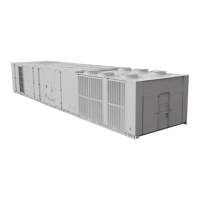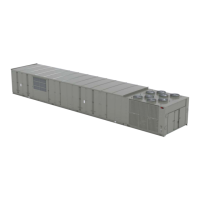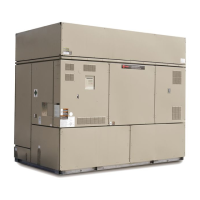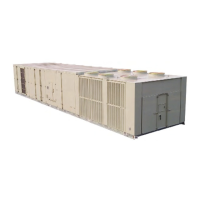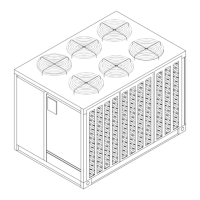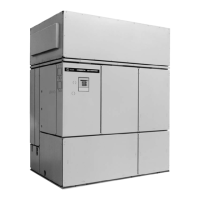154
RT-SVX072A-EN
IImmppoorrttaanntt:: The bearings are manufactured using a
special synthetic lithium-based grease
designed for long life and minimum
relube intervals. Over lubrication can be
just as harmful as not enough.
☐ Use a hand grease gun to lubricate these bearings;
add grease until a light bead appears all around the
seal. Do not over lubricate!
☐ After greasing the bearings, check the setscrews to
ensure that the shaft is held securely. Make sure
that all bearing braces are tight.
☐ Inspect both the main unit control panel and heat
section control box for loose electrical components
and terminal connections, as well as damaged wire
insulation. Make any necessary repairs.
☐ Gas units only - Check the heat exchanger(s) for any
corrosion, cracks, or holes.
☐ Gas units only - Check the combustion air blower
for dirt or blockage from animals or insects. Clean
as necessary.
NNoottee:: Typically, it is not necessary to clean the gas
furnace. However, if cleaning does become
necessary, remove the burner inspection
plate from the back of the heat exchanger to
access the drum. Be sure to replace the
existing gaskets with new ones before
reinstalling the inspection plate.
☐ Check gas piping for leaks.
☐ Gas units only - Open the main gas valve and apply
power to the unit heating section; then initiate a
“Heat” test using the startup procedure described
in “Gas Furnace Startup,” p. 122.
WWAARRNNIINNGG
HHaazzaarrddoouuss GGaasseess aanndd FFllaammmmaabbllee
VVaappoorrss!!
FFaaiilluurree ttoo oobbsseerrvvee tthhee ffoolllloowwiinngg iinnssttrruuccttiioonnss
ccoouulldd rreessuulltt iinn eexxppoossuurree ttoo hhaazzaarrddoouuss ggaasseess,,
ffuueell ssuubbssttaanncceess,, oorr ssuubbssttaanncceess ffrroomm
iinnccoommpplleettee ccoommbbuussttiioonn,, wwhhiicchh ccoouulldd rreessuulltt iinn
ddeeaatthh oorr sseerriioouuss iinnjjuurryy.. TThhee ssttaattee ooff CCaalliiffoorrnniiaa
hhaass ddeetteerrmmiinneedd tthhaatt tthheessee ssuubbssttaanncceess mmaayy
ccaauussee ccaanncceerr,, bbiirrtthh ddeeffeeccttss,, oorr ootthheerr
rreepprroodduuccttiivvee hhaarrmm..
IImmpprrooppeerr iinnssttaallllaattiioonn,, aaddjjuussttmmeenntt,, aalltteerraattiioonn,,
sseerrvviiccee oorr uussee ooff tthhiiss pprroodduucctt ccoouulldd ccaauussee
ffllaammmmaabbllee mmiixxttuurreess oorr lleeaadd ttoo eexxcceessssiivvee
ccaarrbboonn mmoonnooxxiiddee.. TToo aavvooiidd hhaazzaarrddoouuss ggaasseess
aanndd ffllaammmmaabbllee vvaappoorrss ffoollllooww pprrooppeerr
iinnssttaallllaattiioonn aanndd sseettuupp ooff tthhiiss pprroodduucctt aanndd aallll
wwaarrnniinnggss aass pprroovviiddeedd iinn tthhiiss mmaannuuaall..
Coil Cleaning
Regular coil maintenance, including annual cleaning
enhances the unit’s operating efficiency by minimizing
the following:
• Compressor head pressure and amperage draw
• Water carryover
• Fan brake horsepower
• Static pressure losses
At least once each year—or more often if the unit is
located in a “dirty” environment—clean the
evaporator, microchannel condenser, and reheat coils
using the instructions outlined below. Be sure to follow
these instructions as closely as possible to avoid
damaging the coils.
WWAARRNNIINNGG
HHaazzaarrddoouuss CChheemmiiccaallss!!
FFaaiilluurree ttoo ffoollllooww tthhiiss ssaaffeettyy pprreeccaauuttiioonn ccoouulldd
rreessuulltt iinn ddeeaatthh oorr sseerriioouuss iinnjjuurryy.. CCooiill cclleeaanniinngg
aaggeennttss ccaann bbee eeiitthheerr aacciiddiicc oorr hhiigghhllyy aallkkaalliinnee aanndd
ccaann bbuurrnn sseevveerreellyy iiff ccoonnttaacctt wwiitthh sskkiinn oorr eeyyeess
ooccccuurrss..
HHaannddllee cchheemmiiccaall ccaarreeffuullllyy aanndd aavvooiidd ccoonnttaacctt wwiitthh
sskkiinn.. AALLWWAAYYSS wweeaarr PPeerrssoonnaall PPrrootteeccttiivvee
EEqquuiippmmeenntt ((PPPPEE)) iinncclluuddiinngg ggoogggglleess oorr ffaaccee sshhiieelldd,,
cchheemmiiccaall rreessiissttaanntt gglloovveess,, bboooottss,, aapprroonn oorr ssuuiitt aass
rreeqquuiirreedd.. FFoorr ppeerrssoonnaall ssaaffeettyy rreeffeerr ttoo tthhee cclleeaanniinngg
aaggeenntt mmaannuuffaaccttuurreerr’’ss MMaatteerriiaallss SSaaffeettyy DDaattaa SShheeeett
aanndd ffoollllooww aallll rreeccoommmmeennddeedd ssaaffee hhaannddlliinngg
pprraaccttiicceess..
Refrigerant Coils
To clean refrigerant coils, use a soft brush and a
sprayer.
IImmppoorrttaanntt:: DO NOT use any detergents with
microchannel condenser coils. Pressurized
water or air ONLY.
For evaporator and reheat coil cleaners, contact the
local Trane Parts Center for appropriate detergents.
1. Remove enough panels from the unit to gain safe
access to coils.
2. Straighten any bent coil fins with a fin comb.
3. For accessible areas, remove loose dirt and debris
from both sides of the coil. For dual row
microchannel condenser coil applications, seek
pressure coil wand extension through the local
Trane Parts Center.
4. When cleaning evaporator and reheat coils, mix the
detergent with water according to the
manufacturer’s instructions. If desired, heat the
solution to 150° F maximum to improve its
cleansing capability.
IImmppoorrttaanntt:: DO NOT use any detergents with
microchannel coils. Pressurized water
or air ONLY.
5. Pour the cleaning solution into the sprayer. If a
SSeerrvviiccee aanndd MMaaiinntteennaannccee
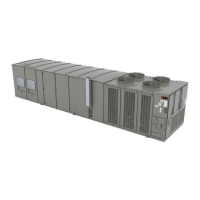
